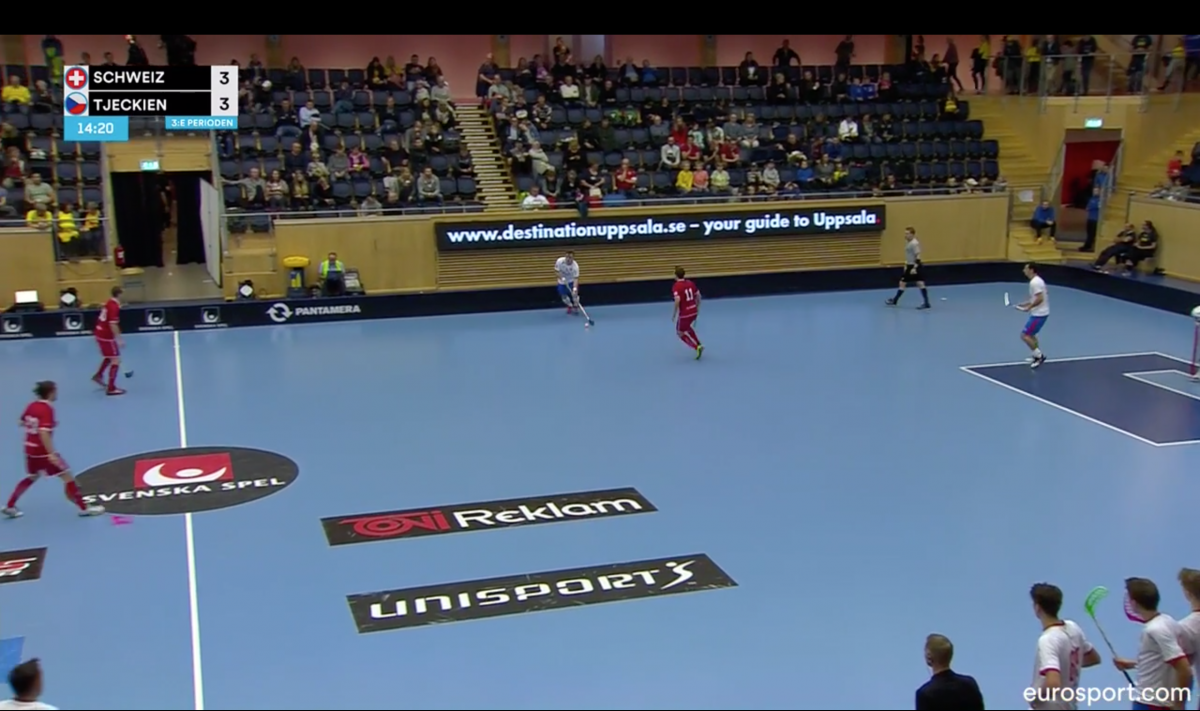The last EFT before the forthcoming World Championships was held in Uppsala, Sweden in the end of October. As the tournament would be the last time the top teams would meet before the WFC, it offered an interesting chance to see how the teams were performing and what kind of conclusions could be made.
The two year period leading to this year's main national team event has been a strong one from the Swiss side. Head coach David Jansson and his staff have earned their praise. The process has been lead from the game and it has been built around a clear tactical framework. This has taken Switzerland one step closer to the favourites Sweden and Finland. During the two year period they have managed to beat Sweden for the first time in its history and have been a very difficult opponent for Finland. The improved results have shown the value of a meticulous process, driven by a clear tactical approach and the building of the team around it.
While the Swiss have shown their potential against the nordic bigs, it has more or less struggled against the Czech Republic. Although the margins in the matches between these two teams have been extremely tight, the Czechs have won the last three encounters. It could be asked whether the Swiss game is build in order to match the strengths of Finland and Sweden, leaving questions open regarding how to beat the Czechs. This is not interesting only from a tactical point-of-view, but also from the WFC tournament format one. As these teams play each other in the group stage, their game affects the eventual semi-final setting.
By using the footage of the recent EFT game between these two teams provided by Eurosport, I will try to look for reasons why Switzerland has been struggling against the Czech Republic. Unfortunately not being able to use video footage in this post, I will try to use still pictures in order to explain why the Swiss have been struggling.
The Swiss have approached the game from a defensive and counter attacking perspective. Especially it has focused on its pressing game and the ability to counter from the positive transitions after the pressing. Their 2-2-1 (starting from the bottom) formation has been a somewhat refreshing breeze in the otherwise rather conservative international level floorball. It has been possible to build this formation around players, whose qualities meet with their chosen approach.. For example Manuel Maurer and Jan Zaugg are extremely good in covering their roles as the top of the formation, working to narrow down the options of the opposition. Behind the top player, the remaining four players form a rather low and tight block, which is difficult to penetrate and to create longer offensive plays. The Swiss 2-2-1 formation has posed big difficulties for example the Finnish offensive game, which has therefore been a big factor for the Swiss to gain good results against Finland. In other words the Swiss have thrown a difficult challenge for the organisation of the opponent's offensive game.
The Swiss do not depend only on the 2-2- 1 formation, as they have also variety. With the Grasshoppers winger duo Claudio Laely and Joel Ruegger the Swiss have also the option to press with two wingers using a 1-2-2 (starting from the bottom)/W formation. This line can be completed by using Alligator Malans- based players such as Tim Braillard, Cristoph Camenisch and Kevin Berry, who all have experience of this formation at the club level.
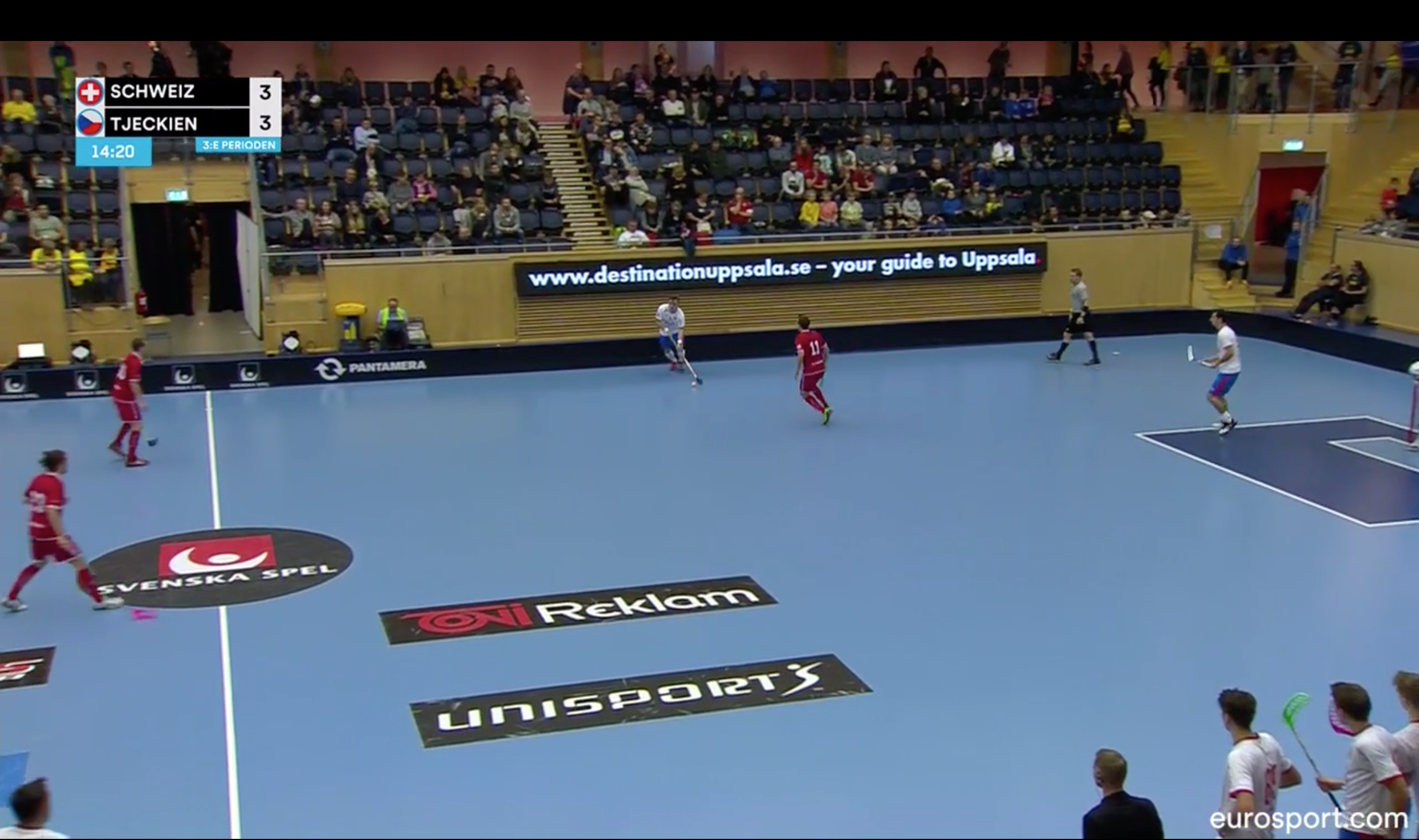
The Swiss 2-2-1: The top player presses the ball carrier in order to narrow down the options. The other four players form a rather low, but active block. The idea is to force the opponent to play on the strong side, to where the Swiss can press. Another option is that the opponent plays the ball in a rather direct way to the offensive corner, where the ball carrier is pressed in a small space, weakening its chances to buy time for the other players to join the attack
We can see that there is some space on the weak side, but this is not a problem as the block of four is balanced and ready to switch side, keeping the four player block rather tight.
Against a rather static offensive team such as the Czechs, the Swiss formation gives the opponent a possibility to play a direct long pass deep in the offensive corner. As the Czechs do not play trough the formation with movement and a clear positioning, it is difficult for them to create a longer offensive play. The ball carrier receiving the ball in the offensive corner must in isolation keep the ball in order to get the other players join the attack. It is in these moments that the Swiss are good in turning such situations into dangerous counter attacks. Another aspect is, that if the opponent does not have a clearly organised offensive zone game, the ball played deep in the offensive corner might lead to unbalanced moments. We can see this for example in the first goal of the game, where the unbalanced Czech formation is immediately punished after loss of possession in the deep.
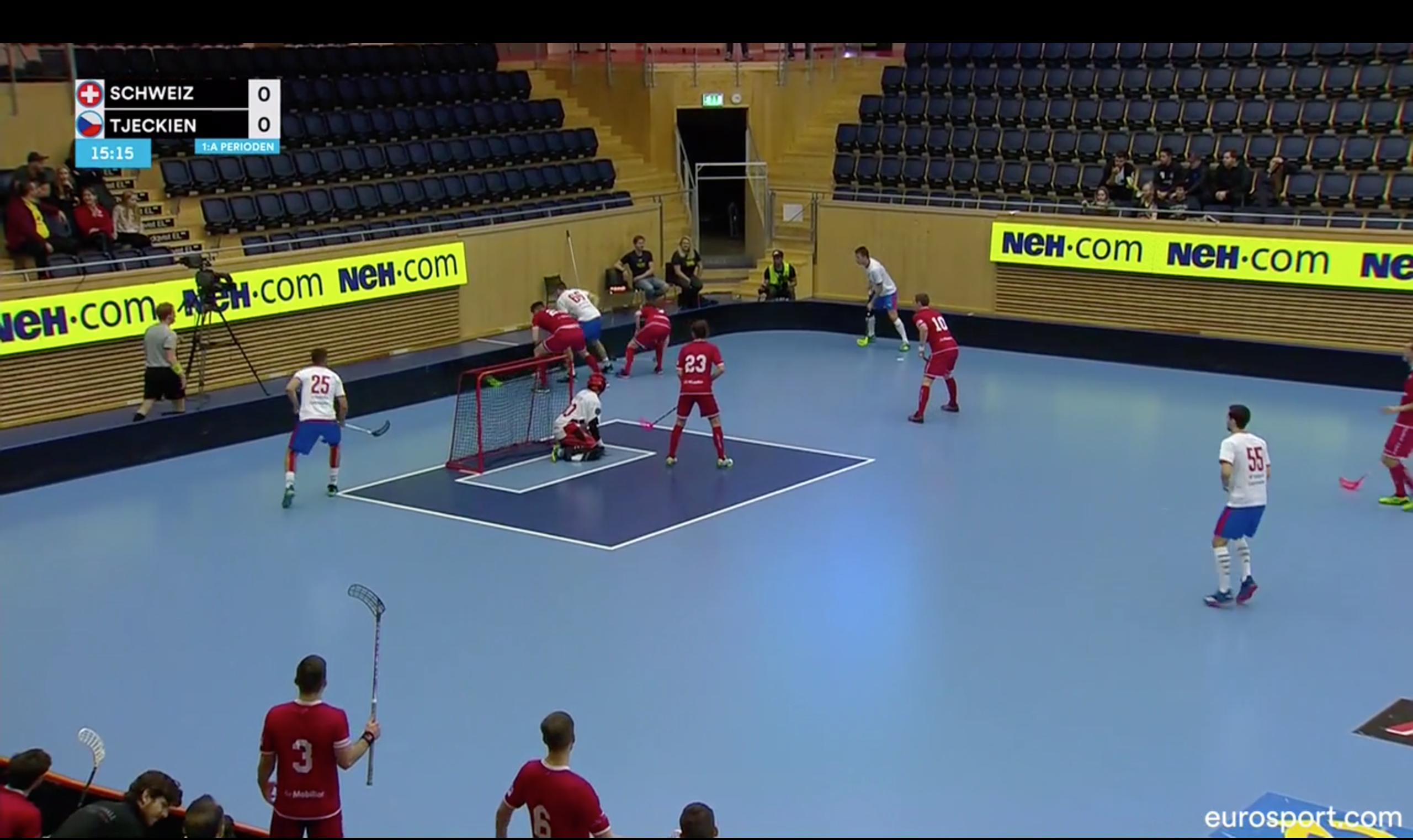 Prior to this situation the Czechs have played a long ball deep in the offensive corner. As this ball is not a result of an organised offensive model, it is also unclear how to solve the situation. This leads to a corner battle, which attracts also a third Czech player. This unbalances the the offense as the middle is left unmanned. The Czechs lose possession, which gives the Swiss a chance to a positive transition and resulting to a 1vs0 for Manuel Maurer
Prior to this situation the Czechs have played a long ball deep in the offensive corner. As this ball is not a result of an organised offensive model, it is also unclear how to solve the situation. This leads to a corner battle, which attracts also a third Czech player. This unbalances the the offense as the middle is left unmanned. The Czechs lose possession, which gives the Swiss a chance to a positive transition and resulting to a 1vs0 for Manuel Maurer
In other words, the Team Switzerland is able to dominate the game without the ball, attracting the opponent to unfavourable positions. As the Swiss have a clear model for these kind of situations, they do not have to rely on individual players to solve each situation at hand, but can rely on the collective model leading to well defined counter models and scoring chances. The same mechanisms have posed difficulties also for Finland and Sweden. This makes Switzerland a difficult team to beat, as the opponent must have a clear model how to play through the Swiss formation, how to create scoring chances while keeping a balance in order not to give the Swiss chances to counter attacks.
Whilst the Swiss are able to control the game against any team, the challenges arise in the moments when they have the ball. In games when they play against an opponent with a similar game plan, such as for instance the Czech Republic. Against the Czechs, the Swiss are the team who probably have more ball possession, compared to games against Finland and Sweden. A game plan relying heavily on moments without the ball will be put under a test, when it is met with another similar approach.
The game against the Czechs showed, that Switzerland is still short of a comprehensive and thorough game model regarding the moments of ball possession. It can be argued that the Swiss are not that comfortable in moments of possession. First of all these could be seen in the moments of positive transitions, during which there is a very strong emphasis on the fast counter. Even in moments when the game would call to neutralise the situation and possibly start again with an attempt for a longer possession. In the game against the Czech Republic. Switzerland gave away many possessions due to forced counter attacks, leading to the game becoming a coast to coast -style game and therefore receiving dangerous scoring chances. It could be asked whether the mindset of fast counters in moments of transition is the optimal one, if it comes with the expense of losing the control of the game?
The game also showed that the Swiss has still a lot to do in the phase of ball possession, in the moments of longer attacks and especially during the build up. Whilst the defensive game is well defined and organised, the same cannot be said when possessing the ball. As often at the national team level, the offensive game relies a lot on players who know each other from club floorball. This is also the case regarding Switzerland. This indeed brings a lot of variability between the offensive lines, as the the playing stems more from shared best club level practices. On the other hand this reveals a lack of structure and organisation of the offensive game. This could be seen on how much the playing varied depending on which line was on the field, and what were the attributes and tendencies of the individual players composing the game of each line.
The challenges regarding the Swiss offensive game are twofold. The first aspect was the lack of a movement with the ball, or a well defined positioning, which would force the Czech formation to move and therefore open up spaces. Instead, the Swiss encountered challenges when they would move the ball in a rather static formation. A static build up relying on rather long passes does not move enough the Czech formation, giving them time to reorganize under the ball.
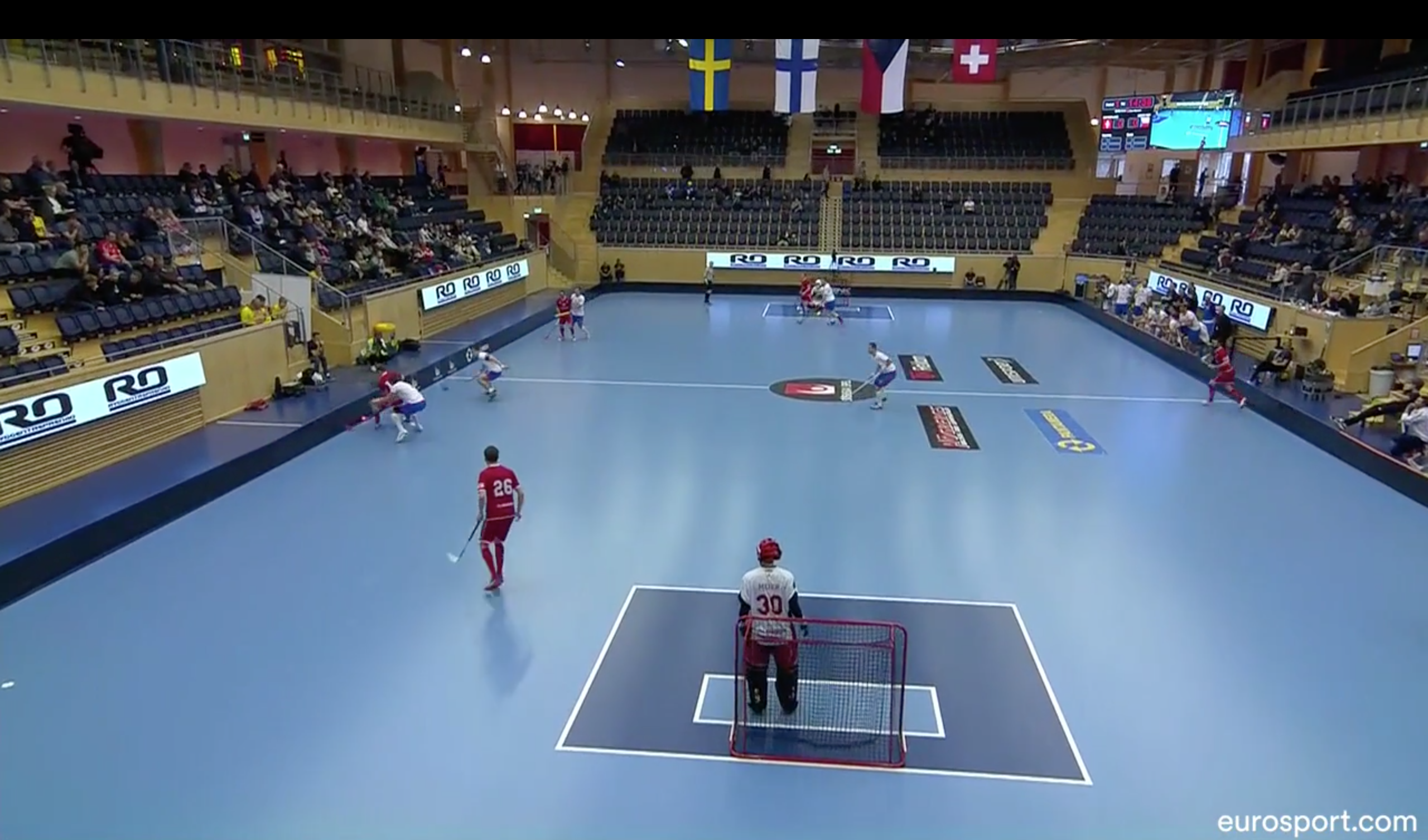
The static formation of three behind without movement by using long passes does not move enough the opponent's formation. This again gives the opponent an opportunity to press leading to situations like this. The Swiss player runs out of options to pass the ball or move, which makes him a target for pressing and leading to a good scoring chance for the opponent. Even though the Swiss could switch the side, the opponent would still have enough time to reorganize.
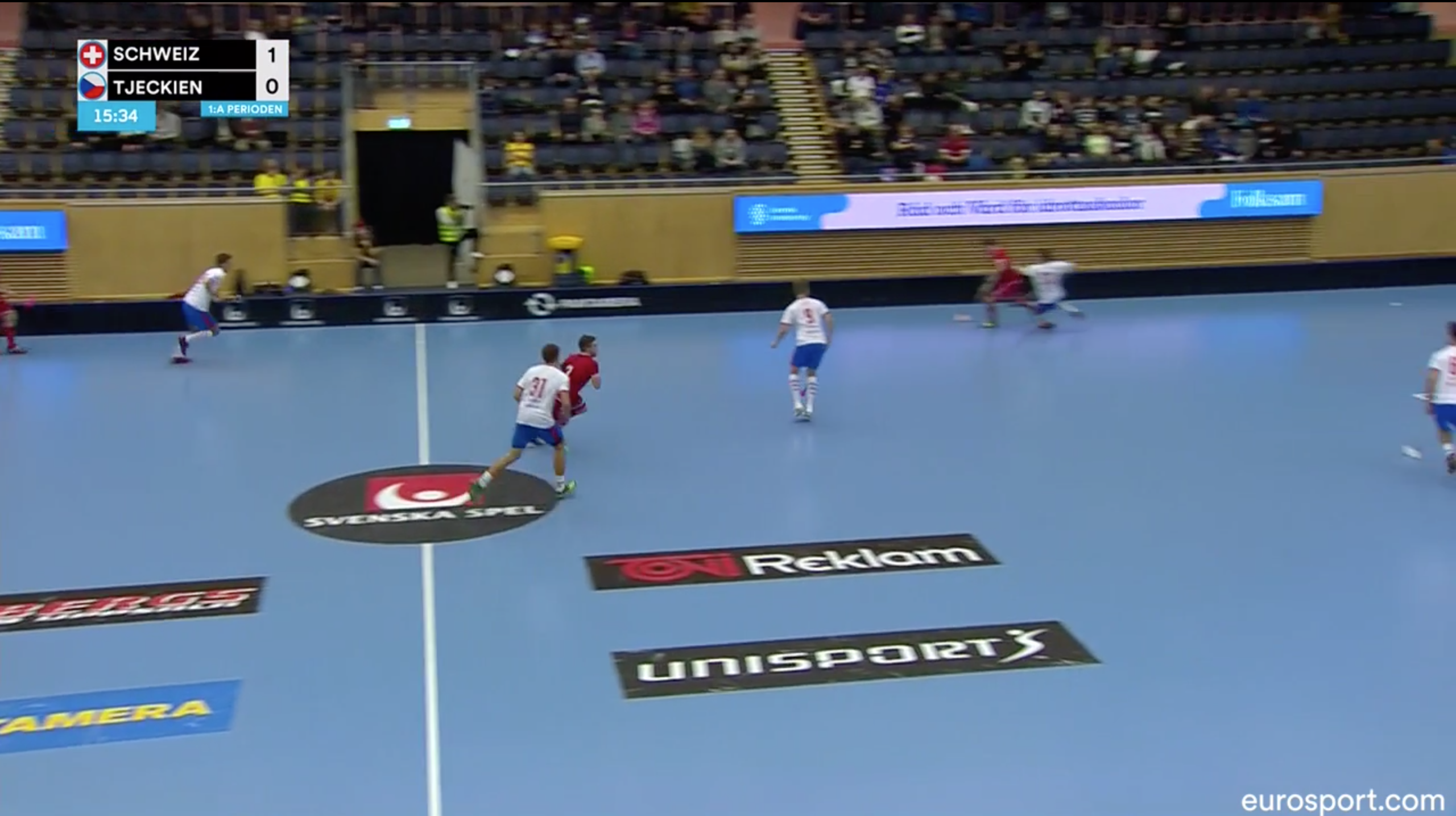 As in the photo above, also in this the Swiss player has a very limited set of options. This forces the ball carrier to pass the ball to a player in a negative body position. In such a situation the receiving player is already pressed from behind, leading to also having very limited options for continuing the play. One option is to pass in the middle, which when successful, in the best scenario opens up a possible scoring change. On the other hand when this is not successful, it makes the team vulnerable to a dangerous counter attack after losing the ball in the middle.
As in the photo above, also in this the Swiss player has a very limited set of options. This forces the ball carrier to pass the ball to a player in a negative body position. In such a situation the receiving player is already pressed from behind, leading to also having very limited options for continuing the play. One option is to pass in the middle, which when successful, in the best scenario opens up a possible scoring change. On the other hand when this is not successful, it makes the team vulnerable to a dangerous counter attack after losing the ball in the middle.
In the match we could also see attempts to build up with more movement. In such situations the Swiss should look how to improve the use of the space created by the diagonal movement. As the space created by the diagonal movement is not properly filled, or this done with the right timing, it stops the play and gives the opponent the time to organise itself.
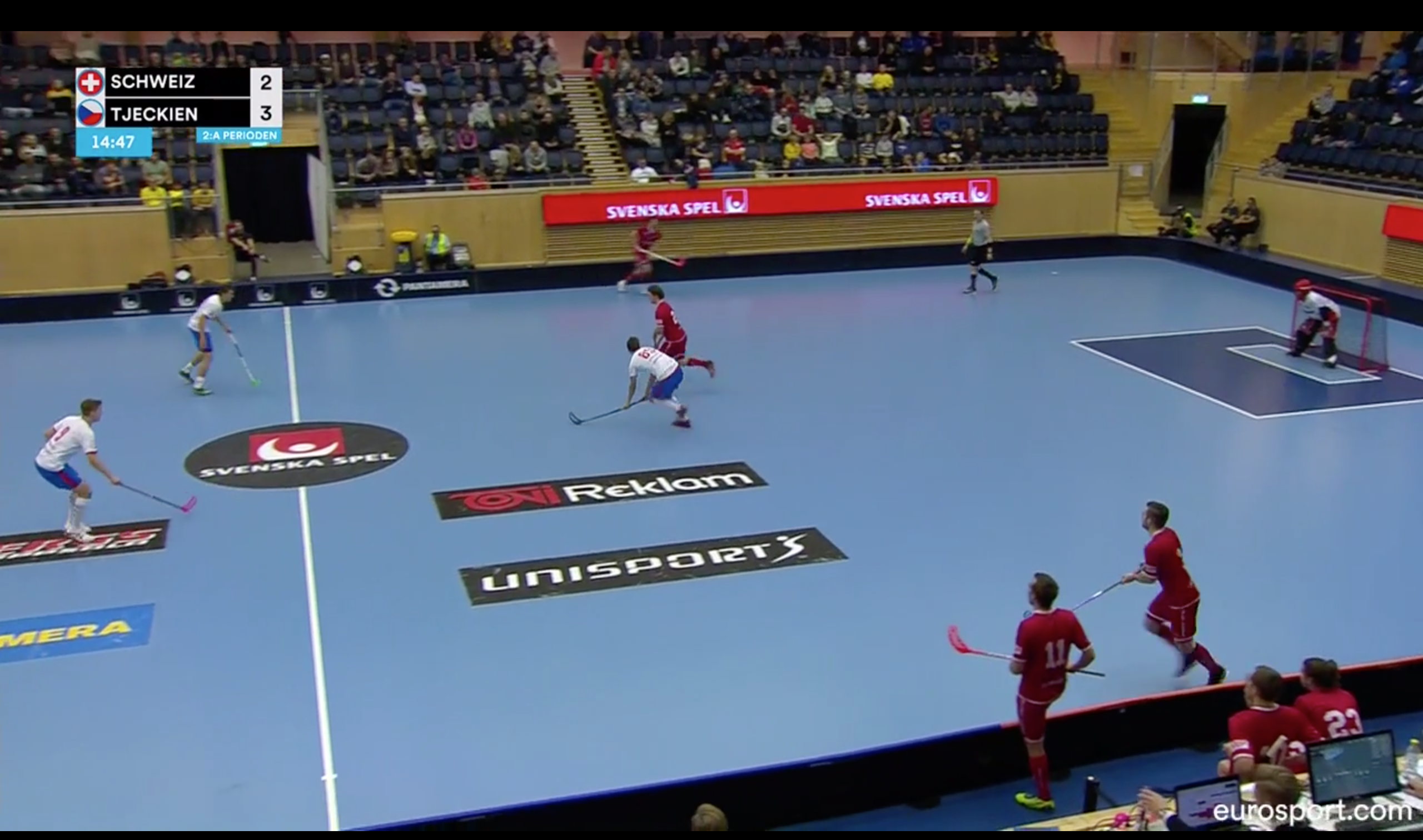
The Swiss player moves with the ball towards the Czech formation, forcing it to squeeze in order to close the middle. At the same time the player on the right side is dropping do be available for a pass back. This opens up some space on the side.
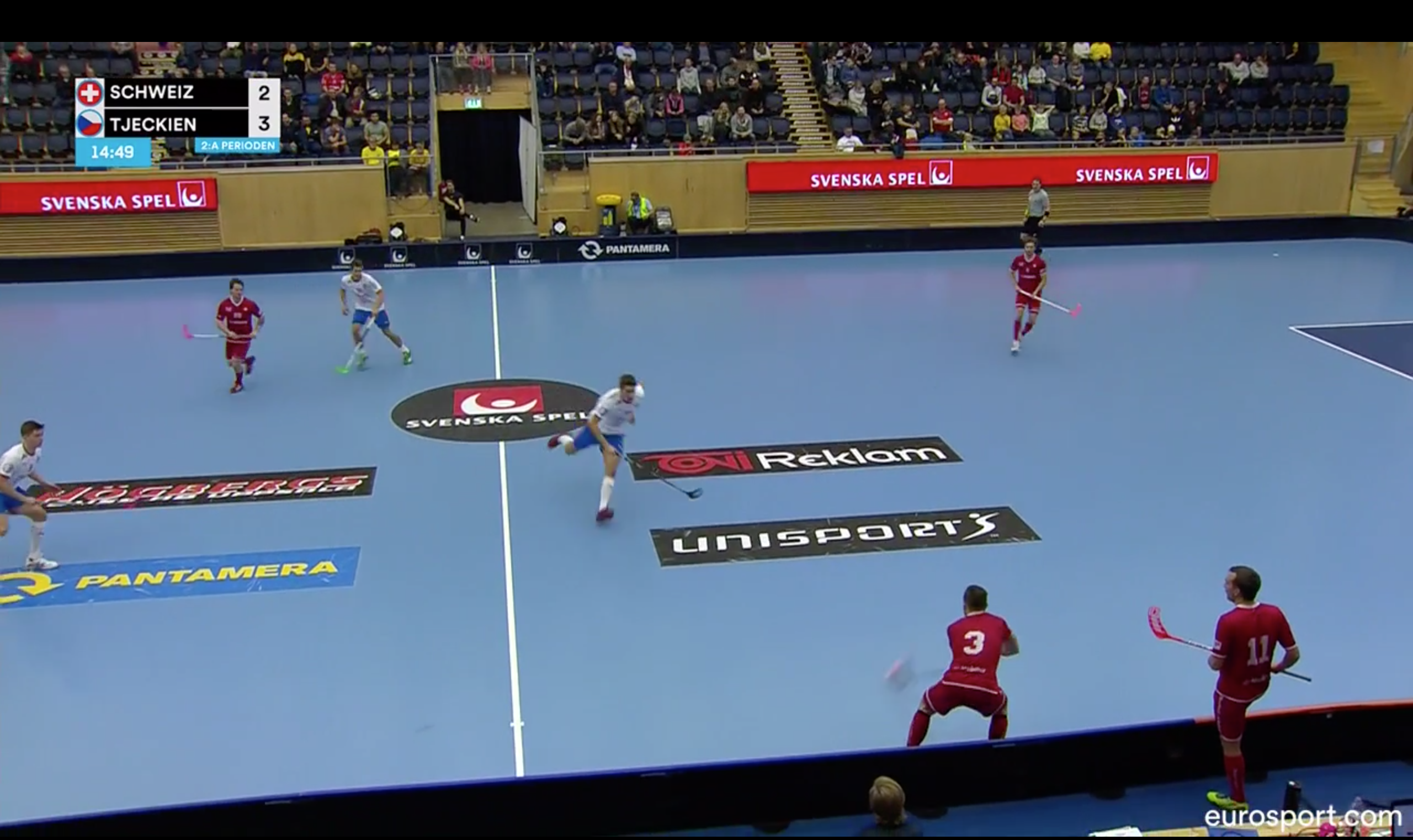
The ball is passed back by the ball carrier. The player receiving he ball passes it quick to the left wing. This attracts the opponent to move towards the ball. which again makes the opponent's formation move in order to close the middle. At the same time the player who made the movement is now being marked by the opponent on the weak side. This action would eventually open some space on the right wing, if it is filled correctly with the right timing.
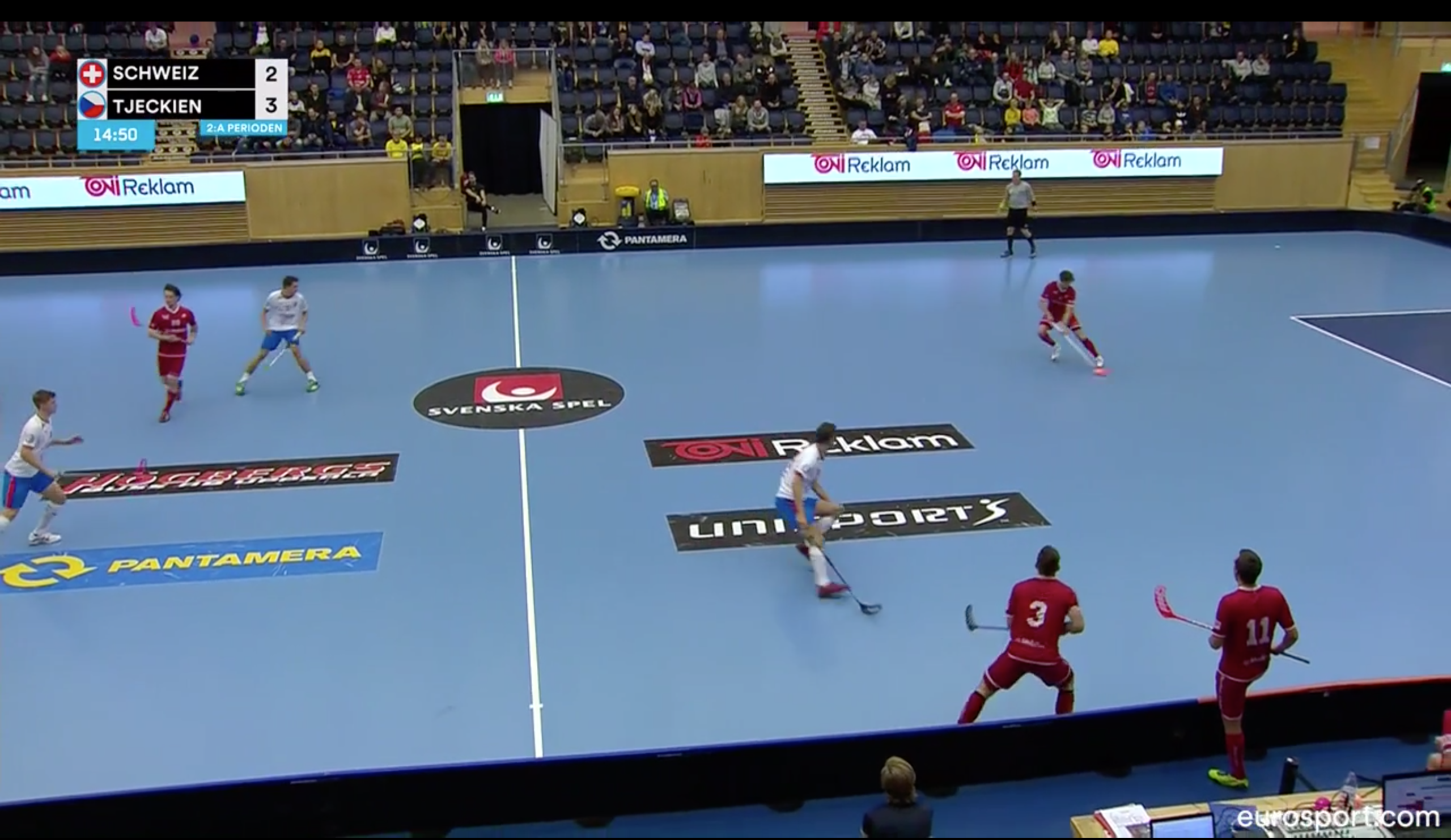 In this picture we can see a space opening to be filled in order to play through the first level of the opponent's formation
In this picture we can see a space opening to be filled in order to play through the first level of the opponent's formation
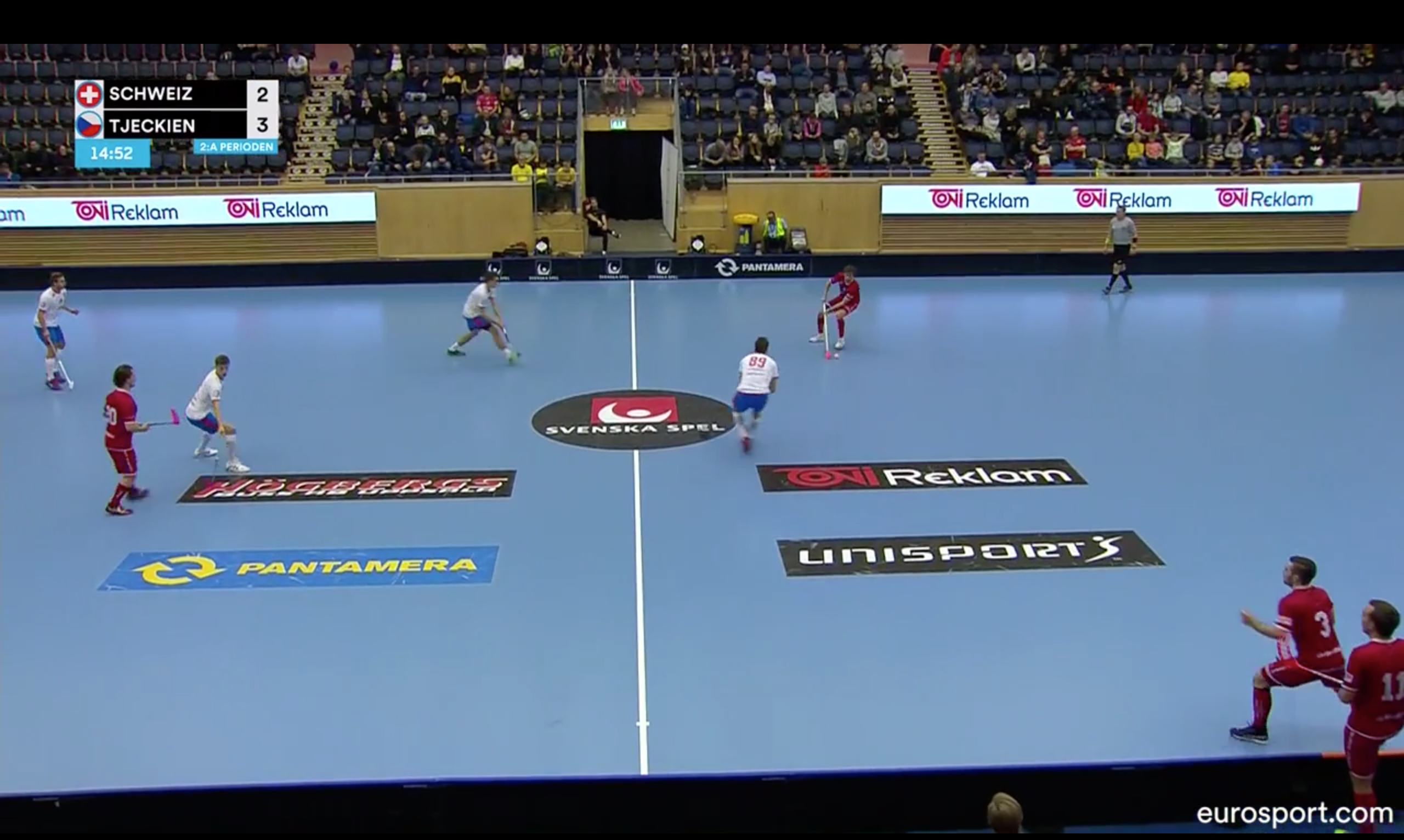 As the space created on the right wing is not filled, the play is stopped as the opponent can again organise itself under the ball.
As the space created on the right wing is not filled, the play is stopped as the opponent can again organise itself under the ball.
Whilst Switzerland had its challenges with its offensive game, it also showed some potential and positive aspects. The lines lead by Manuel Engel and Cristoph Meier could at times perform the build up with more movement and to create the opponent difficulties by using the middle lane when attempting to play through the opponent's formation. Switzerland could create dangerous scoring chances from longer possessions, as they were able to move the opponent and fill the created spaces.
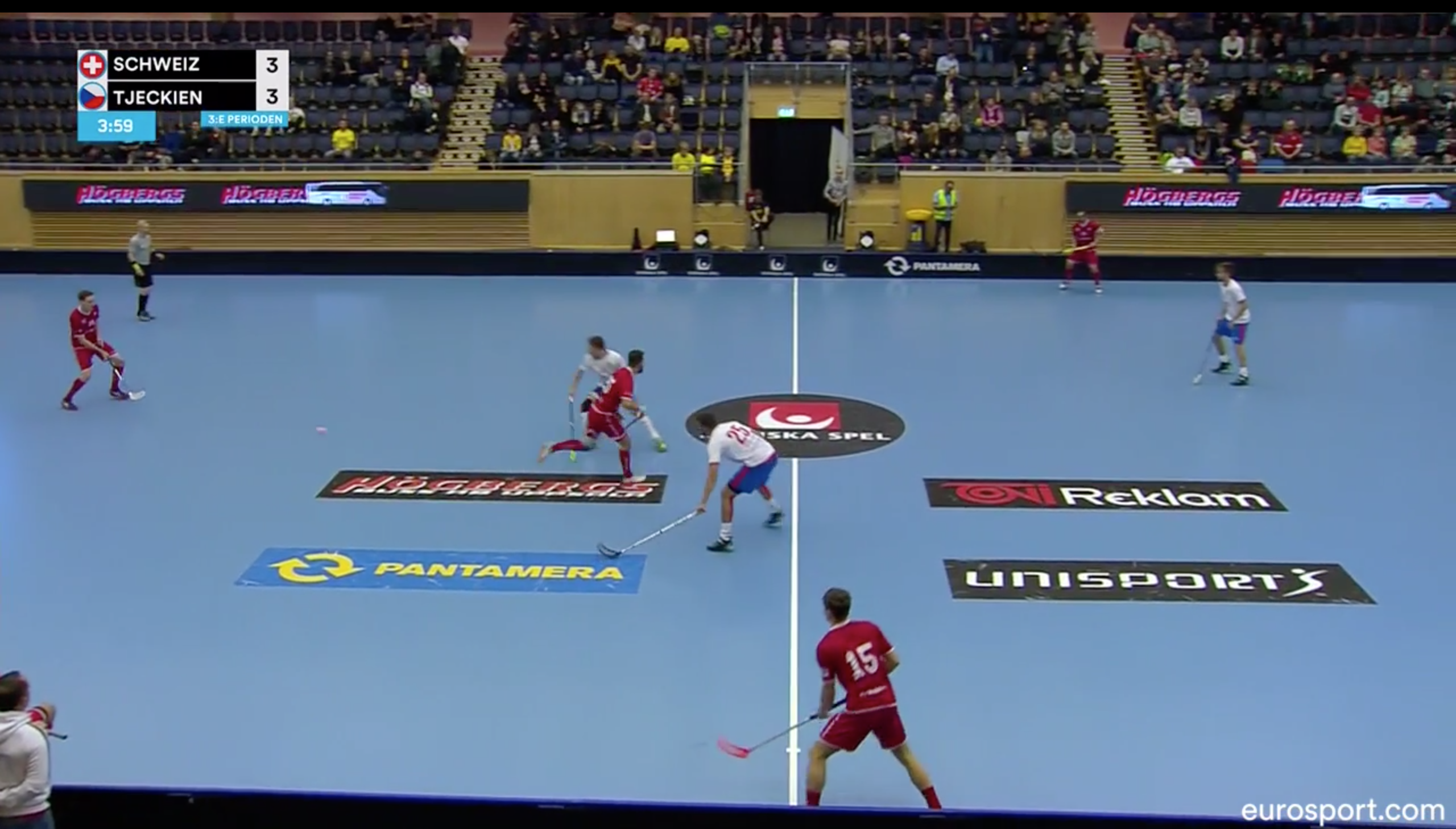 The Swiss player has moved with the ball towards the Czech formation, making it react and squeeze in order to close the middle. The ball carrier after passing it behind continues his movement making himself available for a pass in the middle. At the same time the space created from the movement is filled on the right side with the right timing, giving the ball carrier more options to continue the play.
The Swiss player has moved with the ball towards the Czech formation, making it react and squeeze in order to close the middle. The ball carrier after passing it behind continues his movement making himself available for a pass in the middle. At the same time the space created from the movement is filled on the right side with the right timing, giving the ball carrier more options to continue the play.
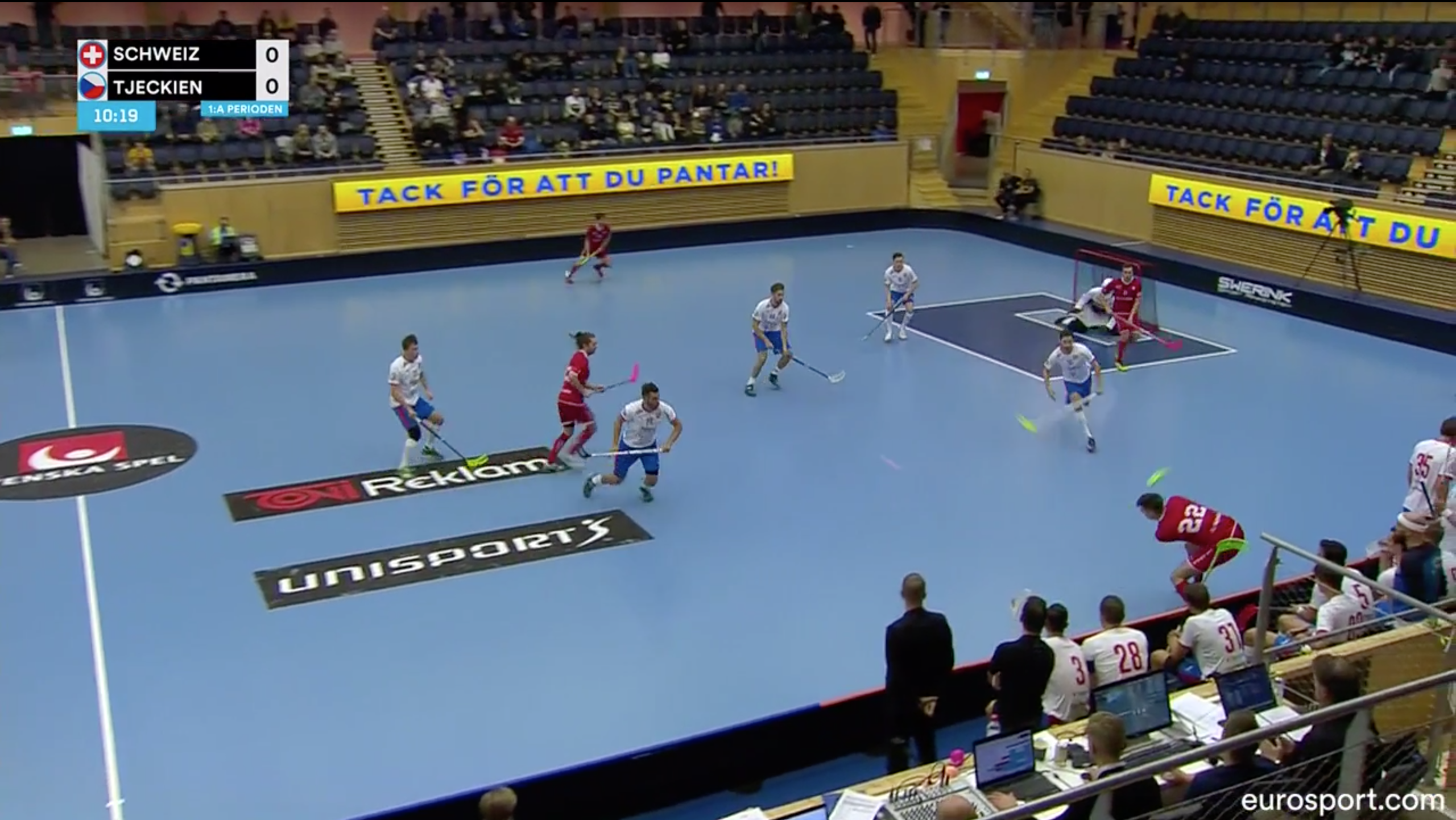
A similar play leading to a great scoring chance in the second period by the Engel line. This line would later score Switzerland's second goal in the same style. Movement towards the formation, the opened space filled up at the right moment giving then options to continue the play. Here the ball carrier has basically 3 different possibilities, of which two are potential scoring chances.
To summarise the game, Switzerland did not encounter major threats by the Czech offensive game. It could control the game rather well without the ball, and it could keep the Czechs away from dangerous scoring changes for the major part of the game. Instead the difficulties stemmed from the problems regarding the offensive game, leading to counter attacks and penalties. Nevertheless Switzerland has taken a big step during this period prior to the forthcoming World Championships, it still has areas to improve their offensive game. At best the Swiss offensive game is of good quality, but this is more or less dependent on individuals and lines, instead of a clear structure and framework how to move and play trough the opponent's defensive formation. In this game we could see that there is still some randomness in the offensive game, which created difficulties and gave the Czechs the chance to win the game, although after a penalty shootout.
If we think about the WFC, the challenges regarding the offensive game might not be a problem only against the Czech Republic, but also against Finland or Sweden. We might as well see that these teams take use of these mentioned challenges and with this try to take Switzerland out of their comfort zone. The higher the level of the opponent, the more important is the role of the quality of ball possession. Not only in terms of scoring, but also as means of having a better control of the game. Even if the emphasis is on the moments without the ball and the transitions, the ability of holding the ball with quality would give Switzerland more tools in the tough matches. The more time Switzerland can keep the opponent off the ball, the better are its chances. As Switzerland does not have the best roster of the tournament, it should to look how to fill the gap with organisation and structure.
If Switzerland is to maximise its potential, it should somehow find the solutions to its offensive game. If it can find the those – like they have done regarding their defensive game - it could take that last step in its already admirable process and cause an upset for one of the favourites.

